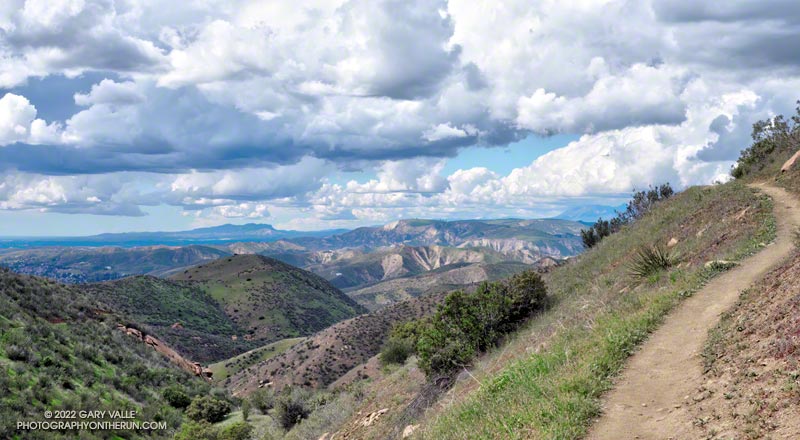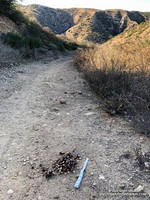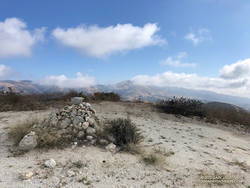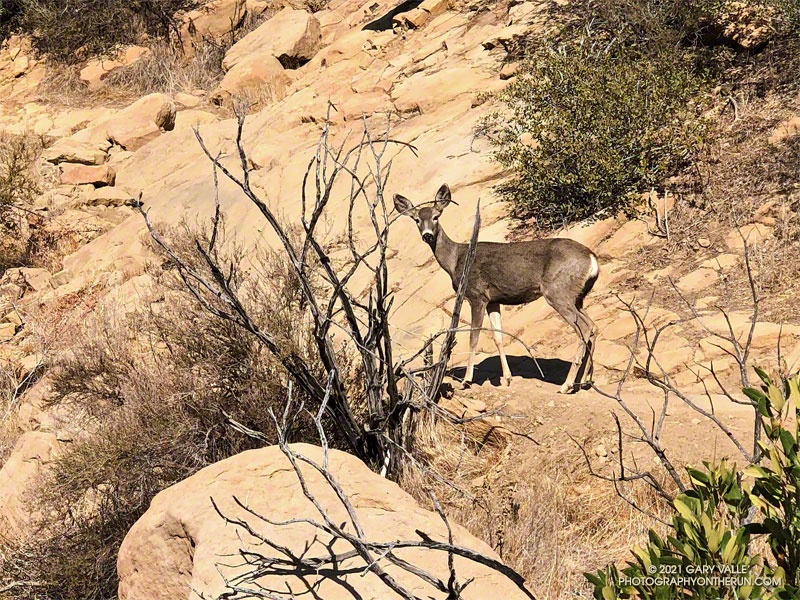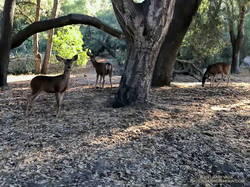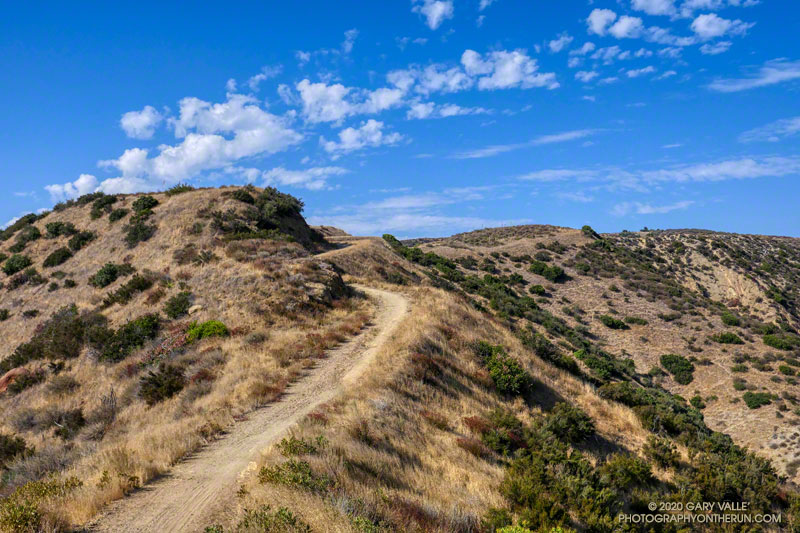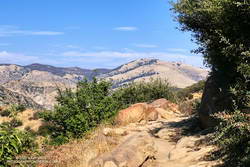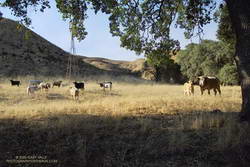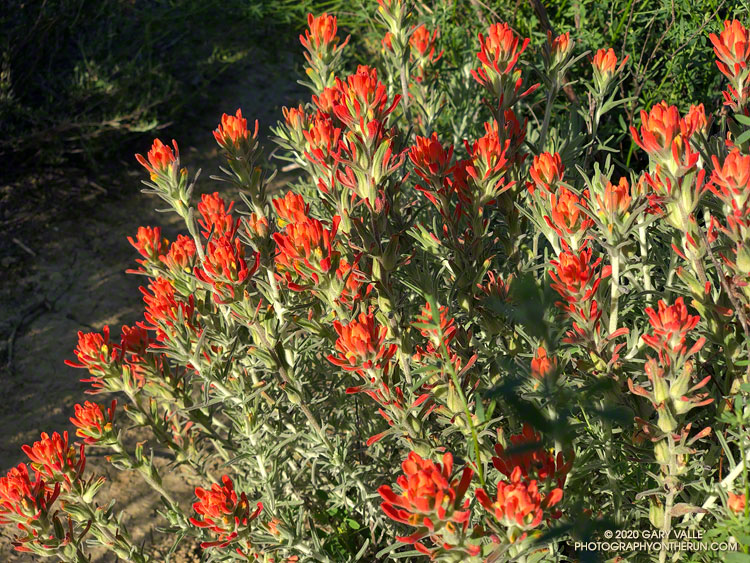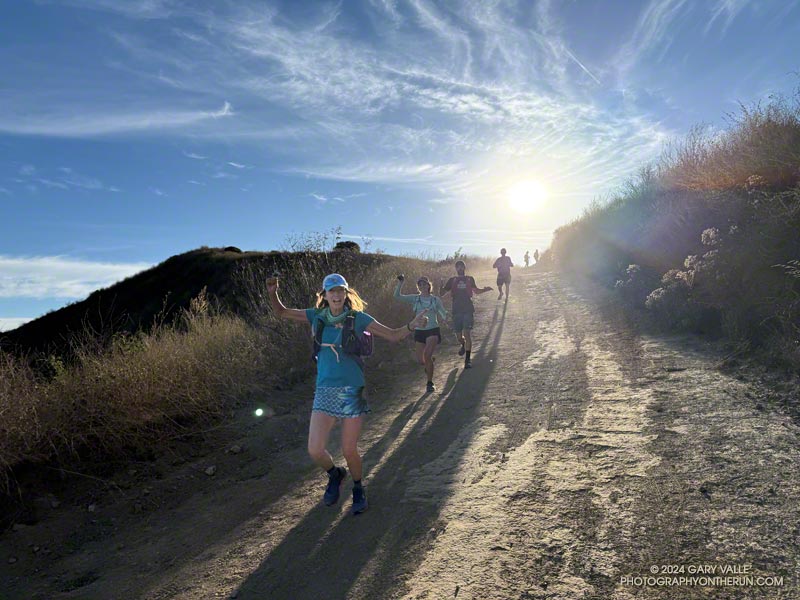
Ahead, the lights of two runners turned this way and that, and behind me more headlamps danced up the canyon. The moon was high in the sky and nearly full. I took advantage of a smooth stretch of fire road, and turned off my headlamp to enjoy running in the surreal light.
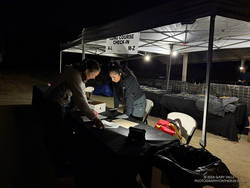
I was in Cheeseboro Canyon and a mile or so into the 2024 No Name 50K. Along with several other runners, I had opted for the early start. Partly because there’s something special about running in the hours before dawn, but also because strong Santa Ana winds were forecast, and I wasn’t sure how hot and windy it was going to get. So far, so good. The only wind was a sometimes cool, sometimes warm, down-canyon breeze.
Usually, when I run Cheeseboro Canyon, it’s from the Victory Trailhead at Ahmanson, and I run down the canyon. It was good to be running up the canyon for a change. The Cheeseboro Canyon Trail is a combination of fire road and single track that gains about 500′ over the 4+ miles to the Sheep Corral Trail junction. There are several very short, steep, rocky sections, but most of the trail is straightforward and enjoyable. Because of all the rain the past two years, the trail near Sulfur Springs was a bit muddy. Running by headlamp, I managed to step in the muckiest of the mud.
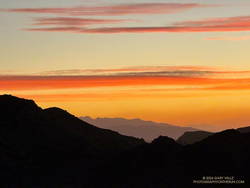
From the top of Cheeseboro, it’s about a mile over to Palo Comado Fire Road on a well-used, up-and-down single track. Just before Palo Camado, I stopped at an overlook to take in the view to the east. San Gabriel Peak and Mt. Wilson were silhouetted in the distance, and a few orange-red clouds preceded the sun.
Once on Palo Comado Fire Road, it took about 15 minutes to get up to China Flat. The timing was perfect — the warm light of the new sun highlighting Simi Peak and the greens and golds of the oak grasslands.
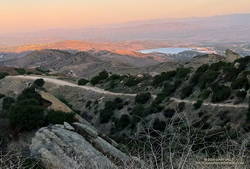
The aid station at Albertson Mtwy Fire Road marked the beginning of a 3-mile downhill to Lang Ranch. I put out of mind that we would be coming back up this hill and just enjoyed the descent.
Following a quick stop at the Lang Ranch aid station, I retraced my steps on Albertson Fire Road back to the Alapay/Lang Ranch Ridge Trail and the start of a scenic 3.5-mile keyhole loop. This memorable segment sets the tone from the start, gaining about 500′ in a mile. The route is a variation of the popular “Lang Ranch Loop,” and the support from the hikers on the trail was much appreciated. So was the encouragement from the awesome group of local runners (in the title photo) — each of the three times I passed them. I still hear their cowbell!
After returning to the Lang Ranch Aid Station, I started up Albertson Fire Road a second time. The volunteer at the Alapay/Lang Ranch Ridge Trail checked my bib number, and I began the long climb back to China Flat.
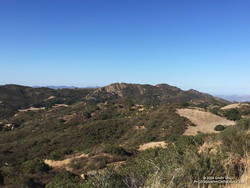
After doing the steep climbs on the Lang Ranch loop, the grade on Albertson didn’t seem so bad. Plus, the weather was cooperating. We were on the second day of a Santa Ana wind event, and I had envisioned running into a 20 mph headwind here. Other than a couple strong gusts, the wind was more of a cooling breeze.
The runner passing me confirmed that the Albertson climb was made for poles — if only I had them. I’d done Albertson on a training run and debated using them for the race. Poles are helpful in a lot of ways, but more efficient uphill propulsion is probably the most important.
After a false summit or two, I eventually reached the aid station at the top of the climb. The smiling volunteers asked me if I needed anything. I told them I was good to go and continued down into China Flat. I could relax for a while. It would be mostly downhill until the aid station in Palo Comado Canyon — about 3.5 miles away.
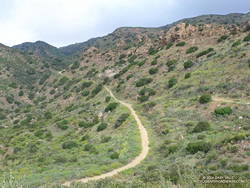
Running down Palo Comado from China Flat was a bit like the run down Albertson, except it was 20 degrees warmer. With the low humidity, I reminded myself to stay hydrated and not pound the downhill. The Cheeseboro Ridge section of the course was a few miles ahead, and the last thing I needed was crampy legs.
At the Palo Comado aid station, I grabbed a peanut butter sandwich and headed up the hill. Like the climbs at Lang Ranch, the hill was steep but relatively short. As I started the descent into Cheeseboro Canyon, I looked across to the power lines on Cheeseboro Ridge. There were runners over there, and I wondered how they were doing. I would find out soon enough.
At the Cheeseboro aid station, I filled my Camelbak to the brim, put some chips in a baggie to eat on the run, and started up the fire road toward Cheeseboro Ridge.
The Cheeseboro Ridge segment of the course follows an SCE powerline service road for about three miles, gaining more than 700′ along the way. On a hot day, it can be very hot, and on a windy day, very windy. There is zero shade. The Cheeseboro Remote Weather Station is passed about a mile up the service road.
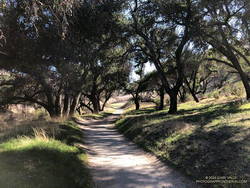
Keeping in mind that the station measures the temperature inside a white, ventilated instrument housing several feet off the ground, the Cheeseboro RAWS midday temp was around 78degF and the wind was 16 mph out of the ENE, gusting to 29 mph. On the fire road, the in-the-sun temp was at least in the mid-80s but didn’t feel too bad.
I was glad to get to the high point of the ridge at the rocky overlook. There were still a couple of small hills to go, but from the viewpoint, it was going to be mostly downhill to the finish.
Many thanks to SoCal Trail, the volunteers, photographers, runners, and everyone involved for a great race!

